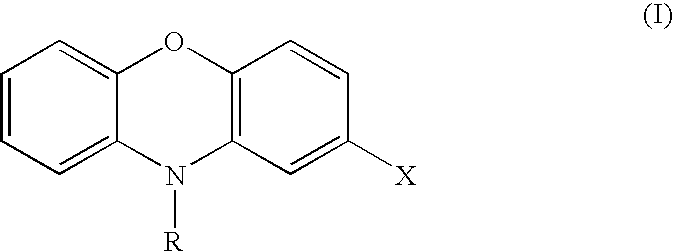Substituted phenoxazines and acridones as inhibitors of AKT
a technology of phenoxazines and inhibitors, which is applied in the field of substituted phenoxazines and acridones as inhibitors of akt, can solve the problems of unknown exact mechanism, unknown exact mechanism, and inability to identify exact mechanism
- Summary
- Abstract
- Description
- Claims
- Application Information
AI Technical Summary
Benefits of technology
Problems solved by technology
Method used
Image
Examples
Embodiment Construction
[0107] As described in more detail below, the invention provides compositions that modulate the activity of AKT family kinase proteins. Specifically, the invention provides a number of phenoxazine and acridone compounds that inhibit AKT phosphorylation and kinase activity. The invention provides compositions for and methods of modulating AKT activity, inhibiting cell growth, treating cancer, treating transplant rejection, and treating coronary artery disease based upon the phenoxazine and acridone compounds of the invention.
[0108] As used herein, the term “AKT” refers any member of the AKT subfamily of the AGC (protein A, protein G, protein C) family of kinases whose individual members are serine / threonine kinases. The nucleotide and amino acid sequences for AKT orthologs from a variety of species (including human, mouse, chicken, zebrafish, Xenopus, Drosophila melanogaster, Caenorhabditis elegans, Hydra, and Anopheles) are known in the art. Generally speaking, the individual membe...
PUM
| Property | Measurement | Unit |
|---|---|---|
| diameter | aaaaa | aaaaa |
| diameter | aaaaa | aaaaa |
| diameter | aaaaa | aaaaa |
Abstract
Description
Claims
Application Information
 Login to View More
Login to View More - R&D
- Intellectual Property
- Life Sciences
- Materials
- Tech Scout
- Unparalleled Data Quality
- Higher Quality Content
- 60% Fewer Hallucinations
Browse by: Latest US Patents, China's latest patents, Technical Efficacy Thesaurus, Application Domain, Technology Topic, Popular Technical Reports.
© 2025 PatSnap. All rights reserved.Legal|Privacy policy|Modern Slavery Act Transparency Statement|Sitemap|About US| Contact US: help@patsnap.com



